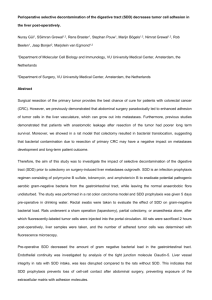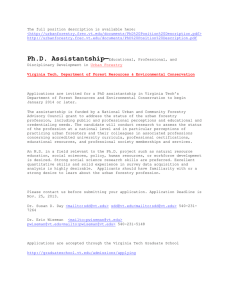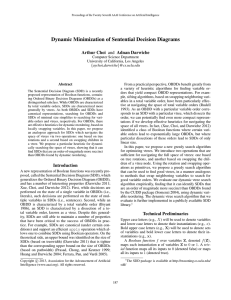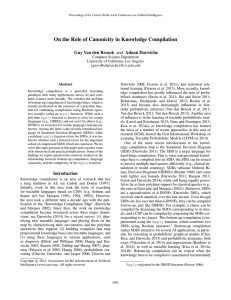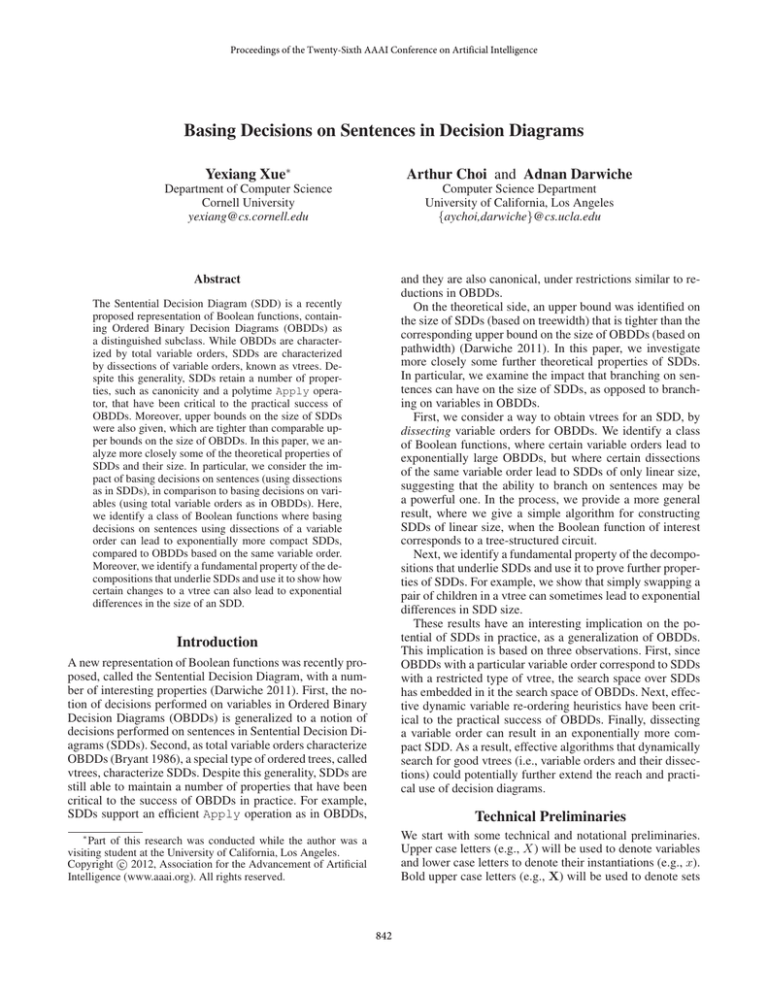
Proceedings of the Twenty-Sixth AAAI Conference on Artificial Intelligence
Basing Decisions on Sentences in Decision Diagrams
Yexiang Xue∗
Arthur Choi and Adnan Darwiche
Department of Computer Science
Cornell University
yexiang@cs.cornell.edu
Computer Science Department
University of California, Los Angeles
{aychoi,darwiche}@cs.ucla.edu
Abstract
and they are also canonical, under restrictions similar to reductions in OBDDs.
On the theoretical side, an upper bound was identified on
the size of SDDs (based on treewidth) that is tighter than the
corresponding upper bound on the size of OBDDs (based on
pathwidth) (Darwiche 2011). In this paper, we investigate
more closely some further theoretical properties of SDDs.
In particular, we examine the impact that branching on sentences can have on the size of SDDs, as opposed to branching on variables in OBDDs.
First, we consider a way to obtain vtrees for an SDD, by
dissecting variable orders for OBDDs. We identify a class
of Boolean functions, where certain variable orders lead to
exponentially large OBDDs, but where certain dissections
of the same variable order lead to SDDs of only linear size,
suggesting that the ability to branch on sentences may be
a powerful one. In the process, we provide a more general
result, where we give a simple algorithm for constructing
SDDs of linear size, when the Boolean function of interest
corresponds to a tree-structured circuit.
Next, we identify a fundamental property of the decompositions that underlie SDDs and use it to prove further properties of SDDs. For example, we show that simply swapping a
pair of children in a vtree can sometimes lead to exponential
differences in SDD size.
These results have an interesting implication on the potential of SDDs in practice, as a generalization of OBDDs.
This implication is based on three observations. First, since
OBDDs with a particular variable order correspond to SDDs
with a restricted type of vtree, the search space over SDDs
has embedded in it the search space of OBDDs. Next, effective dynamic variable re-ordering heuristics have been critical to the practical success of OBDDs. Finally, dissecting
a variable order can result in an exponentially more compact SDD. As a result, effective algorithms that dynamically
search for good vtrees (i.e., variable orders and their dissections) could potentially further extend the reach and practical use of decision diagrams.
The Sentential Decision Diagram (SDD) is a recently
proposed representation of Boolean functions, containing Ordered Binary Decision Diagrams (OBDDs) as
a distinguished subclass. While OBDDs are characterized by total variable orders, SDDs are characterized
by dissections of variable orders, known as vtrees. Despite this generality, SDDs retain a number of properties, such as canonicity and a polytime Apply operator, that have been critical to the practical success of
OBDDs. Moreover, upper bounds on the size of SDDs
were also given, which are tighter than comparable upper bounds on the size of OBDDs. In this paper, we analyze more closely some of the theoretical properties of
SDDs and their size. In particular, we consider the impact of basing decisions on sentences (using dissections
as in SDDs), in comparison to basing decisions on variables (using total variable orders as in OBDDs). Here,
we identify a class of Boolean functions where basing
decisions on sentences using dissections of a variable
order can lead to exponentially more compact SDDs,
compared to OBDDs based on the same variable order.
Moreover, we identify a fundamental property of the decompositions that underlie SDDs and use it to show how
certain changes to a vtree can also lead to exponential
differences in the size of an SDD.
Introduction
A new representation of Boolean functions was recently proposed, called the Sentential Decision Diagram, with a number of interesting properties (Darwiche 2011). First, the notion of decisions performed on variables in Ordered Binary
Decision Diagrams (OBDDs) is generalized to a notion of
decisions performed on sentences in Sentential Decision Diagrams (SDDs). Second, as total variable orders characterize
OBDDs (Bryant 1986), a special type of ordered trees, called
vtrees, characterize SDDs. Despite this generality, SDDs are
still able to maintain a number of properties that have been
critical to the success of OBDDs in practice. For example,
SDDs support an efficient Apply operation as in OBDDs,
Technical Preliminaries
We start with some technical and notational preliminaries.
Upper case letters (e.g., X) will be used to denote variables
and lower case letters to denote their instantiations (e.g., x).
Bold upper case letters (e.g., X) will be used to denote sets
∗
Part of this research was conducted while the author was a
visiting student at the University of California, Los Angeles.
c 2012, Association for the Advancement of Artificial
Copyright Intelligence (www.aaai.org). All rights reserved.
842
of variables and bold lower case letters to denote their instantiations (e.g., x).
A Boolean function f over variables Z maps each instantiation z to 0 or 1. The conditioning of f on instantiation x,
written f |x, is a sub-function that results from setting variables X to their values in x. A function f essentially depends on variable X iff f |X =
6 f |¬X. We write f (Z) to
mean that f can only essentially depend on variables in Z.
A trivial function maps all its inputs to 0 (denoted false) or
maps them all to 1 (denoted true).
Consider a Boolean function f (X, Y) with disjoint sets
of variables X and Y. If
(a) vtree
f (X, Y) = (p1 (X) ∧ s1 (Y)) ∨ . . . ∨ (pn (X) ∧ sn (Y))
then the set {(p1 , s1 ), . . . , (pn , sn )} is called an (X, Y)decomposition of function f as it allows one to express function f in terms of functions on X and on Y (Pipatsrisawat
and Darwiche 2010). The ordered pairs (pi , si ) are called elements of the decomposition. Moreover, if pi ∧pj = false for
i=
6 j, each pi is consistent (6= false), and the disjunction of
all pi is valid (= true), then we call {(p1 , s1 ), . . . , (pn , sn )}
an (X, Y)-partition of function f (Darwiche 2011). In this
case, each pi is called a prime and each si is called a sub.
We say an (X, Y)-partition is compressed iff its subs are distinct, i.e., si =
6 sj for i 6= j. Finally, the size of a decomposition, or partition, is the number of its elements. Note that by
definition, false can never be a prime in an (X, Y)-partition.
In addition, if true is prime, then it is the only prime.
For example, {(A, B), (¬A, false)} and {(A, B)} are
both (A, B)-decompositions of f = A ∧ B. However, only
the first is an (A, B)-partition. Decompositions {(true, B)}
and {(A, B), (¬A, B)} are both (A, B)-partitions of f =
B, while only the first is compressed.
Note that (X, Y)-partitions generalize Shannon decompositions, which fall as a special case when X contains a
single variable. OBDDs result from the recursive application of Shannon decompositions, leading to decision nodes
that branch on the states of a single variable (i.e., literals). As
we show next, SDDs result from the recursive application of
(X, Y)-partitions, leading to decision nodes that branch on
the state of a set of variables (i.e., arbitrary sentences).
(b) Graphical depiction of an SDD
Figure 1: Function f = (A ∧ B) ∨ (B ∧ C) ∨ (C ∧ D).
contains variables X = {A, B} and the right subtree contains Y = {C, D}. Decomposing function f at node v = 3
amounts to generating an (X, Y)-partition of function f . If
{(p1 , s1 ), . . . , (pn , sn )} is an (X, Y)-partition of function
f at node v = 3, then each prime pi will be further decomposed at node v l = 1 and each sub si will be further
decomposed at node v r = 5. The process continues until we
have constants or literals.
Next, we provide a formal definition of an SDD. If we
denote an SDD by α, then we denote the Boolean function
that SDD α represents by hαi. Formally, we say that α is an
SDD that is normalized for a vtree v iff α and v fall under
one of the three following cases:
• α = ⊥v or α = >v and v is a leaf.1
Semantics: h⊥v i = false and h>v i = true.
• α = X or α = ¬X and v is a leaf with variable X.
Semantics: hXi = X and h¬Xi = ¬X.
• α = {(p1 , s1 ), . . . , (pn , sn )}, v is an internal node,
primes p1 , . . . , pn are SDDs that are normalized for left
child v l , subs s1 , . . . , sn are SDDs that are normalized for
right child v r , and hp1 i, . . . , hpn i is a partition (mutually
exclusive, exhaustive, and hpi i 6= false for all pi ).
Wn
Semantics: hαi = i=1 hpi i ∧ hsi i.
A constant or literal SDD is called terminal. Otherwise, it is
called a decomposition. The size of SDD α is obtained by
summing the sizes of all its decompositions.
Sentential Decision Diagrams (SDDs)
As total variable orders characterize OBDDs, SDDs are
characterized by vtrees. A vtree for a set of variables X is
an ordered, full binary tree whose leaves are in one-to-one
correspondence with the variables in X. Figure 1(a) depicts
a vtree for variables A, B, C and D. As is customary, we
will often not distinguish between a node v and the subtree
rooted at v, referring to v as both a node and a subtree. The
vtree was originally introduced in (Pipatsrisawat and Darwiche 2008), but without making a distinction between the
left and right children of a node. However, we make such a
distinction when dealing with SDDs by using v l and v r to
denote the left and right children of node v.
We can use a vtree to recursively decompose a Boolean
function f , starting at the root of a vtree. Consider node
v = 3 in Figure 1(a), which is the root. The left subtree
1
Although the terminal SDDs representing true and false are
distinct for each leaf node, we will omit the subscript v in >v and
⊥v when it is clear from the context.
843
(a) A vtree
(b) An SDD
(c) An OBDD
Figure 3: Two vtrees that result from dissecting the order
hA, B, C, D, E, F i.
Figure 2: A vtree, SDD and OBDD for (A ∧ B) ∨ (C ∧ D).
literal D in Figure 2(b).
SDDs can be notated graphically as in Figure 1(b), where
a decomposition is represented by a circle with outgoing
edges pointing to its elements, and an element is represented
by a paired box p s , where the left box represents the prime
and the right box represents the sub. A box will either contain a terminal SDD or point to a decomposition SDD. Here,
the number contained in each circle is the vtree node that the
corresponding decomposition is normalized for.
Normalized SDDs are canonical given that they are compressed (Darwiche 2011). An SDD is compressed if all of
its decompositions are compressed. Normalized SDDs also
support a polytime Apply operation, allowing one to combine two SDDs using any Boolean operator.
Upper Bounds
SDDs and OBDDs
A CNF with n variables and pathwidth pw is known to have
an OBDD of size O(n2pw ) (Prasad, Chong, and Keutzer
1999; Huang and Darwiche 2004; Ferrara, Pan, and Vardi
2005). Pathwidth pw and treewidth w are related by pw =
O(w log n); see, e.g., (Bodlaender 1998). Hence, a CNF
with n variables and treewidth w has an OBDD of size polynomial in n and exponential in w (Ferrara, Pan, and Vardi
2005). As for SDDs, (Darwiche 2011) showed that the size
of an SDD need only be linear in n and exponential in w.
BDD-trees are also canonical and come with a treewidth
guarantee. Their size is linear in n but at the expense of being
doubly exponential in treewidth (McMillan 1994). Hence,
SDDs come with a tighter treewidth bound than BDD-trees.
A vtree is said to be right-linear if each left-child is a leaf.
The vtree in Figure 2(a), for example, is right-linear. The
compressed SDD in Figure 2(b) is normalized for this rightlinear vtree. Every decomposition in this SDD has the form
{(X, α), (¬X, β)}, which is a Shannon decomposition, or
of the form (>, β). This is not a coincidence as it holds
for all compressed SDDs that are normalized for right-linear
vtrees. In fact, such SDDs correspond to quasi-reduced OBDDs in a precise sense; see Figure 2(c).2 Consider a quasireduced OBDD that is based on the variable order induced
by the given right-linear vtree. Every decomposition in the
SDD corresponds to a decision node in the OBDD and every
decision node in the OBDD corresponds to a decomposition
or literal in the SDD. In a quasi-reduced OBDD, a literal is
represented by a decision node with 0 and 1 as its children,
e.g., the literal D in Figure 2(c). However, in a compressed
SDD, a literal is represented by a terminal SDD, e.g., the
One can view a vtree as the result of dissecting a total variable order in the following sense.
Definition 1 (Dissection) We say that a vtree T induces a
variable order π if and only if a left-right traversal of vtree
T visits leaves (variables) in the same order as π. In this
case, we also say that vtree T is a dissection of order π.
Figure 3 depicts two different vtrees that result from dissecting the same variable order. Consider now an OBDD α
with respect to a variable order π and an SDD β with respect
to a dissection of order π. We will say in this case that SDD
β is a dissection of OBDD α. Our main goal in this section is
to answer the following question: Can dissecting an OBDD
lead to an exponential reduction in its size? The answer is
affirmative as given by the following theorem.
Dissecting an OBDD
Theorem 1 There exists a class of Boolean functions f , a
corresponding variable order π, and a corresponding vtree
T that dissects order π, such that the quasi-reduced (or reduced) OBDD induced by π is exponentially larger than the
normalized and compressed SDD induced by T .
2
A quasi-reduced OBDD is a minimal-size OBDD that mentions every variable in its variable order in all paths from root to
leaf. Quasi-reduced OBDDs are also canonical, and are at most a
factor n + 1 larger than the corresponding reduced OBDD (Wegener 2000). Quasi-reduced OBDDs can also be found by repeated
applications of the merging rule (without the elimination rule) from
a complete binary decision tree.
We will now consider a class of functions that satisfies the
conditions of Theorem 1. Let X = {X1 , . . . , Xn } and Y =
844
The first part of Theorem 1 follows from the following
corollary, which itself follows immediately from the Sieling
and Wegener bound (Sieling and Wegener 1993).
Corollary 2 A quasi-reduced (or reduced) OBDD for function fn with respect to any variable ordering that starts with
variables X1 , . . . , Xn must have at least 2n nodes.
Thus, the variable order π = hXn , . . . , X1 , Y1 , . . . , Yn i, for
example, yields an OBDD with at least 2n nodes.
We will now show the second part of Theorem 1, in which
we dissect such an OBDD, obtaining an SDD whose size is
only linear in n. In fact, we show a more general result: for
any function that is represented by a tree-structured circuit,
there is an SDD whose size is linear in the number of circuit
variables. The result is based on the following theorem.
Theorem 2 Let f (X) and g(Y) be two Boolean functions
where X ∩ Y = ∅. If ◦ is a Boolean operator, then function
f ◦ g has the following (X, Y)-partition:
{(f, true ◦ g), (¬f, false ◦ g)}.
(a) Formula f1
(b) Formula f2
(c) Formula f4
Moreover, the (X, Y)-partition is compressed when operator ◦ is commutative and not trivial, and function g is not
trivial.
Figure 4: Circuit realizations of a function fn (X, Y) that
satisfies Theorem 1.
Proof If x is an instantiation that satisfies function f , then
(f ◦ g)|x = true ◦ g. Otherwise, if x is an instantiation that
satisfies ¬f , then (f ◦ g)|x = false ◦ g. Hence,
{Y1 , . . . , Yn }. The function fn (X, Y) is defined inductively
as follows:
• If n = 1, then f1 (X1 , Y1 ) = X1 ∧ Y1 .
• If n > 1, then fn (X1 , . . . , Xn , Y1 , . . . , Yn )
{(f, true ◦ g), (¬f, false ◦ g)}
is an (X, Y)-partition of function f ◦ g. For example, when
◦ = ∧, we have
{(f, true ∧ g), (¬f, false ∧ g)} = {(f, g), (¬f, false)}.
= [fn−1 (X1 , . . . , Xn−1 , Y1 , . . . , Yn−1 ) ⊕ Xn ] ∧ Yn
When ◦ = ⊕, we have
where ⊕ is the exclusive or operator.
Figure 4 depicts circuit realizations of function fn (X, Y)
for n = 1, 2, 4. We start with a number of observations about
this function before we prove the main result.
Ln
Lemma 1 fn |xy = i=k+1 xi , where k = 0 if yi = true
for all i; otherwise, k is the largest index where yk = false.
{(f, true ⊕ g), (¬f, false ⊕ g)} = {(f, ¬g), (¬f, g)}.
By definition, the (X, Y)-partition is compressed when
true ◦ g =
6 false ◦ g, which holds when operator ◦ is commutative and not trivial, and function g is not trivial.3
Given Theorem 2, we can construct an SDD of linear size,
for any function that has a tree-structured circuit, as follows. Assuming that each gate has two inputs, we simply
use the circuit structure as our vtree;4 see the circuit in Figure 4(c) and the vtree in Figure 7(a). Note here that there is
a vtree node for each primary input and gate of the circuit.
We can now construct the SDD recursively, as shown in Algorithm 1. Constructing SDDs for primary inputs is the base
case here. Given that we have SDDs for the two inputs of
a gate, we can construct an SDD for the gate immediately
using Theorem 2. Algorithm 1 appeals to two additional results. The first result, from (Darwiche 2011), says that one
can negate an (X, Y)-partition by simply negating its subs.
Proof If yi = true for all i, then fn |xy simplifies to x1 ⊕
. . . ⊕ xn . If k is the largest index such that yk = false, then
yj = true for all j > k. In this case, fk |xy = 0, fk+1 |xy =
xk+1 and, hence, fn |xy = xk+1 ⊕ . . . ⊕ xn .
Lemma 2 For every pair of instantiations x =
6 x? , there is
?
an instantiation y such that fn |xy =
6 fn |x y.
Proof Let k be the largest index for which instantiations x
and x? disagree on variable Xk . Consider the instantiation
y that sets Y1 , . . . , Yk−1 to false and Yk , . . . , Yn to true. By
Lemma 1,
fn |xy = xk ⊕ . . . ⊕ xn
and fn |x? y = x?k ⊕ . . . ⊕ x?n .
3
Suppose function g is not trivial. Then true ◦ g = false ◦ g
implies that 1 ◦ 1 = 0 ◦ 1 and 1 ◦ 0 = 0 ◦ 0. Since 1 ◦ 0 = 0 ◦ 1, we
then have 1 ◦ 1 = 0 ◦ 1 = 1 ◦ 0 = 0 ◦ 0. This implies that operator
◦ is trivial, which is a contradiction. Hence, true ◦ g 6= false ◦ g.
4
If the circuit contains a gate with more than two inputs, the
gate can be replaced with a sub-circuit over just binary gates.
Since xk =
6 x?k and xi = x?i for i > k, we must have
fn |xy 6= f |x? y.
Corollary 1 For every pair of instantiations x 6= x? ,
fn |x 6= fn |x? and, hence, the conditioning of fn on variables X1 , . . . , Xn generates 2n distinct sub-functions.
845
Algorithm 1 sdd-tree(v)
input: A tree-structured circuit with primary output v. Each
gate is non-trivial and has exactly two inputs.
output: A pair of SDDs (α, α? ) representing the function of
circuit v and its negation.
main:
1: if v represents a primary input X then
2:
return (X, ¬X)
3: else
4:
v l , v r ← the two sub-circuits feeding into gate v
5:
(β, β ? ) ← sdd-tree(v l )
6:
(γ, γ ? ) ← sdd-tree(v r )
7:
◦ ← Boolean operator corresponding to gate v
8:
η1 ← Apply(true, γ, ◦) {returns γ, γ ? , > or ⊥}
9:
η0 ← Apply(false, γ, ◦) {returns γ, γ ? , > or ⊥}
10:
α ← {(β, η1 ), (β ? , η0 )}
11:
η1? ← negation of η1 {returns γ, γ ? , > or ⊥}
12:
η0? ← negation of η0 {returns γ, γ ? , > or ⊥}
13:
α? ← {(β, η1? ), (β ? , η0? )}
14:
return (α, α? )
Figure 5: A right-linear vtree.
The second states that applying a Boolean operator ◦ to a
constant and function f yields either a constant, the function
f , or its negation ¬f (see Lines 8 & 9 of Algorithm 1).5
It should be clear that Algorithm 1 has a linear complexity in the number of circuit inputs as it adds at most two
SDD nodes for each recursive call, each of which has two
elements. Since the function fn (X, Y) identified earlier has
a tree-structured circuit, it must then have an SDD of linear size when using the vtree corresponding to its structure.
Figure 7 depicts such a vtree for n = 4, together with the
corresponding SDD. Note that this vtree dissects the order
π = hX4 , . . . , X1 , Y1 , . . . , Y4 i. We then have the following
corollary, which proves the second part of Theorem 1.
size. In the example we introduced in this section, there are
in fact variable orders that lead to OBDDs (and SDDs) of
polynomial size, for example, π = hYn , Xn , . . . , Y1 , X1 i.
However, the fact that dissections can obtain exponential reductions in size for a given variable order, has some interesting practical implications. In particular, it suggests that dynamically searching for good dissections may be a promising direction to pursue. Sifting algorithms, for example,
which are based on swapping neighboring variables in a total
variable order, have been particularly effective for dynamic
variable re-ordering (Rudell 1993). Dissection introduces a
new dimension that would allow SDDs to navigate around
barriers that could be faced when only navigating variable
orders using OBDDs.
Corollary 3 There is a normalized and compressed SDD of
function fn , of size O(n), corresponding to a dissection of
the order π = hXn , . . . , X1 , Y1 , . . . , Yn i.
On the Left-Right Order of Vtrees
We have thus shown that dissecting an OBDD into an SDD
can lead to an exponential reduction in size, suggesting that
the ability to branch on sets of variables (sentences) in SDDs
may be a powerful one.
Figure 5 depicts a right-linear vtree corresponding to
the order π = hX4 , . . . , X1 , Y1 , . . . , Y4 i and Figure 6 depicts the corresponding SDD, which also corresponds to an
OBDD in this case. Hence, the SDD in Figure 7(b) can be
viewed as a dissection of the one in Figure 6.
Finally, we remark that we have identified a class of
Boolean functions, where certain variable orders lead to exponentially large OBDDs, but where certain dissections (respecting the same variable order) lead to SDDs of only linear
In this section, we consider the following question: Can
switching the left and right children of a vtree node lead
to an exponential change in the size of the corresponding
SDD? The answer is affirmative as we show next.
Consider the following function:
n
i−1
_
^
fn (X1 , . . . , Xn , Y1 , . . . , Yn ) =
¬Xj ∧ Xi ∧ Yi .
i=1
j=1
This function has a compressed
of size n,
hV(X, Y)-partition
i
i−1
with the ith prime being pi =
¬X
∧
X
and
the ith
j
i
j=1
sub being si = Yi . Yet, the compressed (Y, X)-partition of
function fn is of size 2n . To see this, consider an instantiation y of variables Y. The sub-function fn |y corresponds
to a disjunction of a set of primes that are unique to instantiation y. Primes are mutually exclusive, so the disjunction
5
To show that true ◦ f ∈ {true, false, f, ¬f }, let 1 ◦ 1 = a
and 1 ◦ 0 = b. If a = b, then true ◦ f is a trivial function. If
a = 1 and b = 0, then true ◦ f = f . Otherwise, a = 0, b = 1
and true ◦ f = ¬f . A similar argument can be used to show that
false ◦ f ∈ {true, false, f, ¬f }.
846
Figure 6: An SDD for the right-linear vtree in Figure 5. The SDD corresponds to an OBDD and is equivalent to the SDD in
Figure 7(b).
erators ◦, i.e., the set F ∗ is the smallest set where F ⊆ F ∗
and where f, g ∈ F ∗ implies f ◦ g ∈ F ∗ , for all Boolean
operators ◦. Moreover, define the basis G of a set F to be the
set of non-false functions g ∈ F ∗ such that for all g 0 ∈ F ∗ ,
if g 0 |= g then g 0 = g. That is, the basis G of a set F is the
set of minimal non-false functions in the closure F ∗ under
the partial ordering |=.
First, we characterize the properties of a basis.
itself is also unique to instantiation y. Thus, there are 2n distinct sub-functions of the form fn |y. Further, instantiations
y are the primes of the unique, compressed (Y, X)-partition
of function fn , which must have size 2n .
There is an SDD of size O(n) for the function fn if it
uses a vtree with root v where: (1) variables X1 , . . . , Xn appear in the left subtree and variables Y1 , . . . , Yn appear in
the right subtree, and (2) the left subtree is right linear for
order Xn , . . . , X1 and the right subtree is right linear for order Y1 , . . . , Yn . If we now switch the left and right subtrees
of root v, the corresponding SDD must have size Ω(2n ) as
it must include a (Y, X)-partition of function fn . Thus, the
left-right order of a vtree can lead to an exponential difference in the size of corresponding SDD.
In the remainder of this section, we show a more general result on the relationship between the compressed
(X, Y)-partition of a function f (X, Y) and its (X, Y)decompositions, which implies our result above. Central to
this general result is the notion of a basis.
Theorem 3 A set of Boolean functions G = {g1 , . . . , gm }
is the basis of a set F = {f1 , . . . , fn } if and only if the
following conditions hold:
(a)
(b)
(c)
(d)
For all gi ∈ G, we have gi 6= false.
For all gi ∈ G and fj ∈ F, either gi |= fj or gi |= ¬fj .
For all gi ∈ G, all Fi = {fj ∈ F | gi |= fj } are distinct.
g1 ∨ · · · ∨ gm = true and gi ∧ gj = false for all i 6= j.
The proof of this theorem is delegated to the Appendix.
Decompositions and Partitions
The Basis of a Set of Boolean Functions
We now have the following interesting theorem.
Let F = {f1 , . . . , fn } be a set of Boolean functions, and
let F ∗ denote the closure of F with respect to Boolean op-
Theorem 4 Let {(g1 (X), h1 (Y)), . . . , (gn (X), hn (Y))}
be an (X, Y)-decomposition of a function f (X, Y), and let
847
Consider now the set S of Boolean functions f1 , . . . , fn
over variables X1 , . . . , Xn , where fi = Xi . The closure of
S under Boolean operators ◦ is the set of all Boolean functions over variables X1 , . . . , Xn . Thus, the basis of set S is
the set of Boolean functions corresponding to the 2n instantiations of variables X1 , . . . , Xn . This is an example where
the size of the basis of Boolean functions S is exponentially larger than the size of the set S. This observation and
Theorem 4 implies the result we showed earlier in the section, in which we showed a function f (X, Y) whose compressed (X, Y)-partition and compressed (Y, X)-partition
have sizes that differ exponentially.
Conclusion
We considered in this paper the size of a decision diagram
from the viewpoint of basing decisions on sentences (i.e.,
sets of variables), as in SDDs, in contrast to basing decisions on literals (i.e., single variables), as in OBDDs. We
first identified a class of Boolean functions where, for a
given variable ordering, there is a dissection of that ordering
that results in an SDD that is exponentially smaller than the
corresponding OBDD. In the process, we provided a general algorithm for constructing compact SDDs from treestructured circuits. We further identified a fundamental property of the decompositions that underlie SDDs, which we
used to show how switching children in a vtree can also lead
to exponential differences in the size of an SDD.
(a) vtree
Acknowledgments
(b) SDD
This work has been partially supported by NSF grant #IIS0916161.
Figure 7: A vtree and its corresponding SDD.
Proofs
Proof of Theorem 3. Note that conjoin and complement
are sufficient to induce the closure F ∗ . We first show that
Conditions (a–d) are necessary for a set G = {g1 , . . . , gm }
to be the basis of set F = {f1 , . . . , fn }.
P be the basis of the functions g1 , . . . , gn . Then P are the
primes of an (X, Y)-partition of function f . Moreover, if
the functions h1 , . . . , hn are mutually exclusive, then P are
the primes of the unique, compressed (X, Y)-partition of
function f .
(a) By definition of a basis.
(b) Suppose that Condition (b) does not hold, i.e., gi 6|= fj
and gi 6|= ¬fj . This implies that gi ∧ fj 6= false. and
gi ∧ ¬fj 6= false. Moreover, function gi ∧ fj is in the
closure F ? . However, gi ∧ fj |= gi , which implies that gi
is not a basis function, which is a contradiction.
(c) Suppose gi has the corresponding set Fi . We want to show
that gi is equivalent to the function
^ ^
γ=
f ∧
¬f .
The proof of this theorem is also delegated to the Appendix.
The importance of this theorem is that it allows one to use
knowledge about the bases of Boolean functions to derive
results about the sizes of (X, Y)-partitions. For example,
we will show next that the basis of a set of Boolean functions can be exponentially smaller or larger than the number
of such functions. We will then show that this implies the
concrete result we showed earlier in the section: The size of
the compressed (X, Y)-partition of a function f (X, Y) can
be exponentially different than the size of its compressed
(Y, X)-partition.
Consider first the set S of all Boolean functions
over varin
ables X1 , . . . , Xn . Note that there are 22 such Boolean
functions. The closure of set S under Boolean operators is
the set S itself. Hence, the basis of set S corresponds to the
set of all 2n instantiations over variables X1 , . . . , Xn . This
is an example where the size of the basis of Boolean functions S is exponentially smaller than the size of the set S.
f ∈Fi
f ∈F \Fi
From Condition (b), we know that either gi |= f or gi |=
¬f for each f ∈ F. Thus, if we show that gi = γ, we
know that each Fi is distinct, since each gi is distinct. By
definition, gi |= f for all f ∈ Fi , and thus gi |= ¬f
for all f ∈ F \ Fi . Moreover, we have that gi |= γ and
further that γ =
6 false since gi =
6 false. If we conjoin to
γ any function in F, we either get back γ or false (by
848
References
construction of γ). Note that any function in the closure
F ∗ can be represented as a disjunction of terms
^ ^
f ∧
¬f .
f ∈H
Bodlaender, H. L. 1998. A partial k-arboretum of graphs
with bounded treewidth. Theoretical Computer Science
209(1-2):1–45.
Bryant, R. E. 1986. Graph-based algorithms for Boolean
function manipulation. IEEE Transactions on Computers
C-35:677–691.
Darwiche, A. 2011. SDD: A new canonical representation of propositional knowledge bases. In Proceedings of
the 22nd International Joint Conference on Artificial Intelligence, 819–826.
Ferrara, A.; Pan, G.; and Vardi, M. Y. 2005. Treewidth in
verification: Local vs. global. In Logic for Programming,
Artificial Intelligence, and Reasoning (LPAR), 489–503.
Huang, J., and Darwiche, A. 2004. Using DPLL for efficient
OBDD construction. In The Seventh International Conference on Theory and Applications of Satisfiability Testing
(SAT), 157–172.
McMillan, K. L. 1994. Hierarchical representations of discrete functions, with application to model checking. In Computer Aided Verification (CAV), 41–54.
Pipatsrisawat, K., and Darwiche, A. 2008. New compilation languages based on structured decomposability. In Proceedings of the Twenty-Third AAAI Conference on Artificial
Intelligence (AAAI), 517–522.
Pipatsrisawat, K., and Darwiche, A. 2010. A lower bound
on the size of decomposable negation normal form. In Proceedings of the Twenty-Fourth AAAI Conference on Artificial Intelligence (AAAI), 345–350.
Prasad, M. R.; Chong, P.; and Keutzer, K. 1999. Why is
ATPG easy? In Design Automation Conference (DAC), 22–
28.
Rudell, R. 1993. Dynamic variable ordering for Ordered
Binary Decision Diagrams. In ICCAD, 42–47.
Sieling, D., and Wegener, I. 1993. NC-algorithms for operations on binary decision diagrams. Parallel Processing
Letters 3:3–12.
Wegener, I. 2000. Branching Programs and Binary Decision
Diagrams. Society for Industrial and Applied Mathematics
(SIAM).
f ∈F \H
for some H ⊆ F. Thus, if we conjoin to γ any function in
the closure F ∗ , we also get back either γ or false. Since
γ ∈ F ∗ , function γ must be a basis function, and thus
γ = gi (since gi |= γ).
(d) First, if γ = g1 ∨ · · · ∨ gm 6= true, then ¬γ 6= false.
Moreover, for all gi ∈ G, gi 6|= ¬γ. Since ¬γ ∈ F ∗ ,
function ¬γ should have been a basis function, which is
a contradiction. Next, if there are gi , gj ∈ G where γ =
gi ∧ gj =
6 false, then γ |= gi and γ |= gj , which by the
definition of a basis, implies that γ = gi = gj , which is a
contradiction.
Next, we show that Conditions (a–d) are sufficient for a set
G to be the basis of a set F. For each function gi ∈ G, let
Fi = {fj ∈ F | gi |= fj }, and let
^ ^
γi =
f ∧
¬f ,
f ∈Fi
f ∈F \Fi
which is in the closure F ∗ . First, by Condition (b), since
gi |= f for all f ∈ Fi , we know that gi |= ¬f for all
f ∈ F \ Fi , and further that gi |= γi . Since gi 6= false by
Condition (a), we also know that γi 6= false, since gi |= γi .
Next, by Condition (c), for any gi and gj for i 6= j, there
is a function f ∈ F where f ∈ Fi and f 6∈ Fj (or vice
versa). Thus, γi |= f and γj |= ¬f (or vice versa), and so
γi ∧ γj = false for all i 6= j. Third, by Condition (d), all
gi ∈ G are mutually exclusive and exhaustive. Since all γi
are mutually exclusive, and since gi |= γi , the functions γi
are also exhaustive. Hence, gi = γi for all i. Fourth, if we
conjoin to gi = γi any function in F ∗ , we either get back
gi = γi or false. As gi = γi ∈ F ∗ , function gi must be a
basis function of F. Finally, since all gi ∈ G are mutually
exclusive and exhaustive, the set G must be a basis of F.
Proof of Theorem 4. Let P be the basis of the functions
g1 , . . . , gn . Since the basis forms a partition (mutually exclusive, exhaustive, and all gj =
6 false), we just need to
show that for each pi ∈ P and instantiations x and x? where
x |= pi and x? |= pi , we must have f |x = f |x? . Suppose
x |= pi and x? |= pi . By Condition (b) of Theorem 3, either
pi |= gj or pi |= ¬gj . Hence, instantiations x and x? imply
the same set of functions gi implied by pi , leading to
_
f |x = f |x? =
hj ,
pi |=gj
which is the sub of prime pi .
Suppose now that functions hj are mutually exclusive.
Consider any two instantiations x and x? such that x |= pi
and x? |= pj where i =
6 j. By Condition (c) of Theorem 3,
primes pi and pj imply different sets gk . Hence,
_
_
f |x =
hj 6=
hj = f |x?
pi |=gj
pj |=gj
since functions hj are mutually exclusive. Hence, the subs
of primes pi and pj are distinct and the (X, Y)-partition is
compressed.
849





